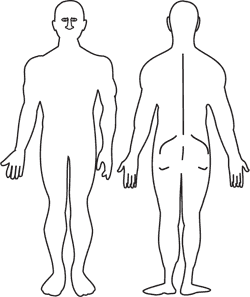
Sara Watkins is the steward for the clerical unit at Haliburton Prevaricators Inc. In her job she gets to talk to many of the clerical workers who work in different departments. For the last month or so she noticed that there were more complaints about aches and pains, and there seemed to be people wearing wrist braces. She spoke to the company's health & safety person but she was told that there was no increase in injuries. Sara remembered that over the last several months many new workstations were hastily set up, and in addition, many of the clerical workers had agreed to work overtime and she wondered if there was any connection. The problem she had was in getting enough information to tie the two together.
Why Survey Workers
With a Body Map?
Work-related musculoskeletal disorders (MSDs), such as carpal tunnel syndrome, are one of the most prevalent categories of work-related injuries, but if caught in time, treatment, and reducing the ergonomic hazard, can greatly reduce the ultimate disability. If there is no intervention, these injuries can become just as disabling and crippling as a broken limb. The first step is early detection. Common signs and symptoms of MSDs can include aching, burning, numbness, pain, tingling, swelling or stiffness in the hand, wrist, elbow, arm, shoulder, neck, back or leg.
Danny Ellsburg was the steward for the molding department at Hapsburg Co. He worked the D shift, one of the four 12-hour shifts. Communication between workers and stewards was still a problem, as this shift schedule was new. Sometimes he wouldn't see the A shift steward for several weeks. Danny knew from his own experience that his back was bothering him more than ever. There was plenty of lifting involved in his job. At first he thought it was just taking time to get used to 12 hour days, so even he didn't say anything, but soon several other workers began to complain in the locker room. What Danny wanted was a way to show that this 12 hour shift was having a bad effect on workers and something had to be done to give them a break.
"A picture is worth a thousand words." We've all heard this and as a tool to help figure out health and safety problems it turns out to be true.
Questions For a Survey of Muskuloskeletal Problems

Have you had any pain or discomfort in the last year?
If yes, mark the area of the drawing which bothers you the most.
Put a check by the word(s) that best describe your problem
- Aching
- Burning
- Cramping
- Loss of color
- Numbness
- Pain
- Swelling
- Stiffness
- Tingling
- Weakness
- Other
Body mapping is a tool that health and safety experts and unions around the world are using to pinpoint problems workers are having, and then using this information to figure out what in the workplace is causing the problems.
The idea of body mapping is simple. Get a group of workers together with diagram of a human body drawn on poster paper, or individually survey workers using a body map. Have the workers mark where they are hurting on the diagram.
Why does this work? Because for many people it is easier using a visual chart than it is using words to show exactly where they are hurting. If you ask someone "where do you hurt?" and they say, "In my back," most of the time that information is not specific enough. "Where in the back?" is the next question. With a body map the person shows exactly where they are hurting.
Body mapping isn't limited to aches and pains. Workers should also mark the diagram if they experience headaches while at work; marks should be made for allergies that are worse at work. Do people have trouble breathing while at work? Or feel shortness of breath? Mark the lungs. Are workers getting stressed out whenever a particular boss is on duty? Mark the map for stress.
It is best if body mapping is done in groups of workers that work in the same department or do the same kind of work. This way, the body map can be used to figure out the cause of the problem. Workers who work in the same department but on different shifts can pass the map along so that everyone is included and a bigger pool of information is created.
Health and Safety Body Map
Some health and safety experts that use body mapping use different colored stickers or markers to show different types of problems:
Red - Back or repetitive strain (ergonomic) injury
Blue - Occupational injuries (e.g. cuts, bruises, broken or fractured bones, eye injuries, electric shock, etc.)
Green - Stress or stress related health effects
Yellow - Chemical exposure/health effects from chemicals
Purple - Occupational diseases (e.g. skin rash, sinus infections, occupational asthma, hearing loss, work related cancer)
